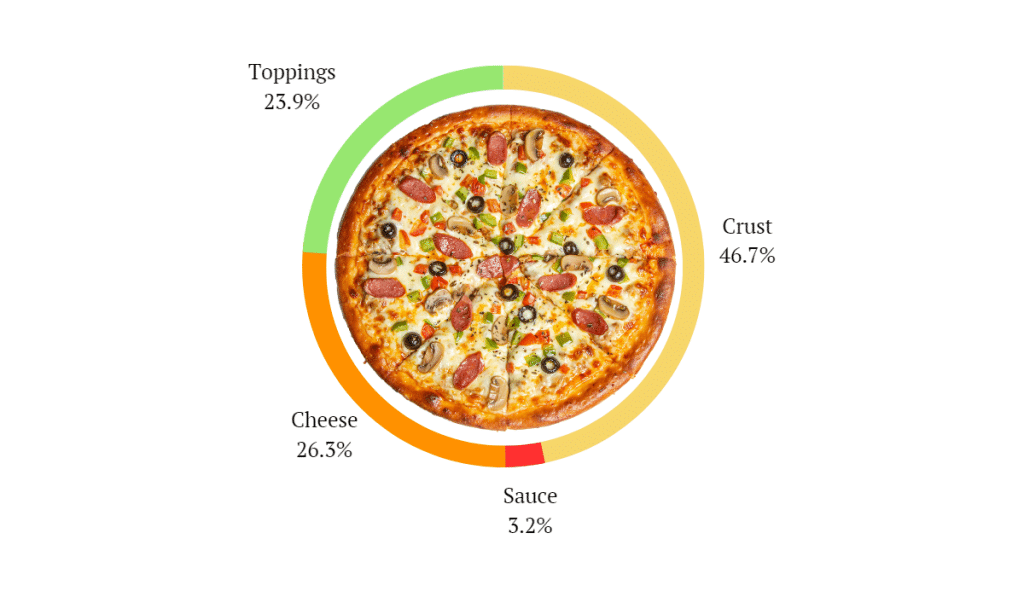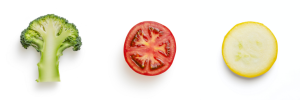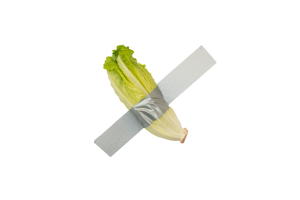If you have ever wondered what nutritional value your favorite cheesy bread holds, then you came to the right place. As an avid cook myself who personally made a lot of pizzas, and tried to stay true to the authenticity of the recipes, I can provide you with sufficient pieces of information. From pineapple to basil, each part of the pizza changes with different types, and that affects the overall nutritional outcome. Today we will take a closer look at the calories in the pizza, and how every ingredient plays a certain role in contributing to its caloric significance, Let’s begin.
There’s 1323-850 Kcal in a 28 cm pizza. Most of the pizza calories come from the crust, cheese, and toppings respectively. The total caloric value depends on the amount and type of these 3 parts of the pizza.

Pizza "Pie" Chart, Pun Intended
Table of Contents
Pizza Crust Calories
A good pizza crust is a foundation for the recipe and a major contributor to the pizza calories. A good crust can make or break the dish. The authentic ingredients of the crust are usually flour, water, yeast, and salt only. Some recipes call for oil, and it will result in a thicker, cake-like texture. Needless to say, that is unhealthy because of the fat content. Due to its carbohydrates rich nature, any manipulation in the crust’s recipe will greatly affect the nutritional value. Pizzas that have a double crust, thick crust, or cake-like crust just as we mentioned will have a higher caloric content. If you want to stay healthy, your best choice will be a thin-crust pizza. Every 100 grams of pizza crust contains 230-270 kcal, with flour being the major contributor here. These calories come mainly from carbohydrates. Here are some common types that are caloric relevant:
- Thin Crust Pizza: The lowest in carbs and hence calories. Obviously, your best choice.
- Thick Crust Pizza: Has a high carb value, and if tastes oily or cake-like then it has fat content as well.
- Stuffed Crust Pizza: It has more cheese, and as a result, will be higher in protein and fat. More on that later.
- Double Crust Pizza: Like thick crust pizza, it has a high carb content.
The nutritional values for a 100 grams pizza crust are:
| Calories | Protein | Fat | Carbs | Fiber | |
|---|---|---|---|---|---|
| Pizza Crust | 266 | 6.6 | 0.7 | 48.6 | 1.8 |
You get it now. If the pizza crust changes in any way, it will affect the nutritional content. If you want to stay healthy, you need to keep in mind these different changes.
Pizza Sauce Calories
Traditional pizza sauce contains mainly tomatoes, olive oil, and other ingredients. With 120 kcal per tablespoon, olive oil is the largest contributor to the caloric value here. However, every pizza has a small amount of sauce, and that’s why it doesn’t add much to the pizza’s calories. Other ingredients are garlic, oregano, chili flakes, and sometimes anchovies. The pizza sauce has a small amount of these ingredients just for flavor and the cook often discarded them after doing so. Obviously, Other unconventional types of pizza sauces have different nutritional labels, but as I have said, only a small amount. Other types may include Alfredo sauce, Pesto sauce, Barbeque sauce, and Buffalo sauce.
The nutritional values for 1 small jar of pizza sauce are:
| Calories | Protein | Fat | Carbs | Fiber | |
|---|---|---|---|---|---|
| Tomato Sauce | 423 | 2.9 | 42.8 | 13.6 | 2.9 |
| Pesto | 499 | 8.5 | 53.6 | 3.1 | 0.9 |
| Alfredo Sauce | 505 | 17.9 | 33.2 | 36 | 0.4 |
| Buffalo Sauce | 574 | 64.9 | 44 | 0.1 | 0 |
| BBQ Sauce | 560 | 6.3 | 26.9 | 79.15 | 6 |
As I have said, a 28 cm pizza only has 2-3 tablespoons, and you’re not going to end up having the whole amount I mentioned earlier.
Pizza Cheese Calories
Cheese is arguably the best part of the pizza and the second largest contributor to its calories. the cheese is what makes the pizza so rich and enjoyable to eat. The pizza has usually mozzarella cheese, which is a semi-soft cheese that is rich in protein but also high in fat. Generally speaking, Hard cheeses have almost equal fat content and protein content, and it also depends on type of the cheese. The harder the cheese is, the lower its fat content. So whatever cheese type you put in a pizza, you can keep that in mind. Also if you order an extra cheesy pizza, and you want to lose some weight, consider ordering the normal one. This way you can decrease your fat intake, and you can always substitute for the protein by ordering lean meat as a topping such as turkey.
Pizza might include other types of cheeses such as provolone and cheddar cheeses. It may include some cheeses for garnish in small amounts such as Parmesan. Here are some of the common cheeses’ nutrition per 100 grams:
| Calories | Protein | Fat | Carbs | Fiber | |
|---|---|---|---|---|---|
| Mozarella | 300 | 22.2 | 22.4 | 2.2 | 0 |
| Cheddar | 403 | 24.5 | 33.1 | 1.3 | 0 |
| Provolone | 351 | 25.6 | 26.6 | 2.1 | 0 |
| Pamesan | 321 | 32.1 | 21.4 | 3.6 | 0 |
| Goat Cheese | 452 | 30.5 | 35.6 | 2.2 | 0 |
If you use a blend of these cheeses you’ll get somehow an average of their calories. I recommend using a 100 g for a 28 cm pizza and you’ll get a nice light pie.
Pizza Toppings Calories
Pizza topping is a large category and a subject for debate. To tackle such a huge variety of ingredients, we can categorize them into the following:
Here are some toppings examples for you to consider (100 grams):
- Herbs: Added for flavor in small amounts, herbs usually don’t add many calories to the dish. The best example here is basil.
- Veggies: We can further divide these into two types. Non-starchy vegetables, such as spinach, mushroom, and bell pepper. And starchy vegetables such as potatoes and corn (yes I found a pizza recipe with potatoes and rosemary). The first type of vegetables have a very low caloric content, while the second type adds to the overall carbs and should be fine if used in moderation.
- Meats: Processed or not, meats give a high protein content to the pizza. Lean meats such as chicken and turkey tend to give the pizza a lower fat content while fattier meats like pepperoni do the opposite. Always try to have a pizza with lean meat as it has a better caloric structure.
- Pineapple: if you’re wondering where to fit pineapple in all of this, then the answer is it doesn’t. Pineapple is a fruit, and besides tomatoes pineapple is the only fruit that made it on a pizza. It has a very low caloric value (50 kcal/100 grams) and therefore calorically it shouldn’t pose a problem.
| Calories | Protein | Fat | Carbs | Fiber | |
|---|---|---|---|---|---|
| Mixed Veggies | 86 | 3.2 | 2.9 | 16.7 | 3.2 |
| Lean Beef | 186 | 30.3 | 6.2 | 0 | 0 |
| Chicken Breasts | 114 | 25.6 | 2.5 | 0 | 0 |
| Pepperoni | 494 | 32.1 | 44 | 0 | 0 |
The Healthiest Pizza Recipe
I will now share with you my favorite pizza recipes. I usually prepare a 28 cm, thin-crust pizza for two people. And I top that with 2 tablespoons of sauce, 100 g of mozzarella cheese. Feel free to add any type of cheese you want, but I would avoid goat cheese because it is very fatty. I usually prepare a supreme pizza with mixed veggies and lean meat, However, you can make a pepperoni pizza with 50 grams of pepperoni and it would still be okay. A classic Margherita pizza has the lowest amount of calories because it is basically just a cheese sandwich with sauce. With that being said, you should adjust the recipe according to your nutritional needs by altering the portion sizes, And these examples are a good place to start. It is okay to play with the ingredients, now that you have knowledge about them.
Calories for the examples I gave you are:
| Calories | Protein | Fat | Carbs | Fiber | |
|---|---|---|---|---|---|
| Classic Margherita | 850 | 35.9 | 24 | 102.9 | 4.1 |
| Pepperoni | 1097 | 47.25 | 46 | 102.9 | 4.1 |
| Supreme | 950 | 48.1 | 25.35 | 111.25 | 5.7 |
Conclusion
Overall, Pizza is a healthy dish when consumed in moderation and can help you achieve your body goals. By reading what’s above, you can now have an idea of what a healthy pizza looks like. You can now analyze any pizza recipe and tweak it a little bit to fit your nutritional needs. It is worth mentioning here that pizza is a self-limiting dish, and it can carry a certain amount of ingredients. Now I want to hear from you. Is there any topping or a type of cheese I missed? I added the most common ingredients that I felt that anyone would use. Let me know in the comments. Share this article with a fellow pizza lover that is caloric aware. Have a good day and a good Pizza!


